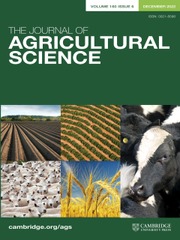Article contents
A study of the habits of zebu cattle in Tanganyika
Published online by Cambridge University Press: 27 March 2009
Extract
1. The habits of five Tanganyika Shorthorn zebus and their suckling calves were studied during periods of 72 consecutive hours at monthly intervals in each of the first 6 months of the calves' lives, during the ‘dry’ season of the year.
2. Cows grazed for 7·16 hr. per day while grass was green and plentiful, but, as grazing became dry and sparse, they ate silage at night for up to 3 hr., and reduced their grazing time by about 2 hr. The ratio of rumination time to eating time tended to increase as grazing became drier and as silage eating increased. The average ratio was 1·01 to 1.
3. All calves were actively grazing for 4·0 hr. per day by the second month, and for 5·6 hr. per day by the fifth month. They ate silage diffidently in the second month, but they were eating silage for 1·7 hr. per night at 6 months. Rumination was observed in a calf at 18 days of age, but was consistently observed in the second month when calves ruminated for 6·1 hr. per day. The ratio of rumination time to grazing time for calves declined from 1·5 to 1 in the second month to 1·1 to 1 in the fifth month. Rumination time among calves was more closely related to silage eating than to grazing time.
4. The calves acted as individuals in the first month, and thereafter their eating habits were determined more by their dam than by their age. Day-time rumination pattern was a characteristic of the age of calf, but night-time rumination by calves was more closely correlated to that of their dams.
5. Calves suckled for an average period of 9·2 min. per suckle. There was very little variation with age, but frequency of suckles decreased from 9·5 times per day at 1 month to 5·6 times per day at 6 months. The fastest-growing calf suckled less frequently for shorter periods, suggesting readier availabilty of more milk.
6. Suckling intensity was evenly spread over the 24 hr. during the first 2 months, but thereafter suckling became increasingly confined to nighttime while the cattle were yarded.
7. It was concluded that artificial feeding divided into three equal feeds per day at 05.00, 13.00 and 21.00 hr. for the first 2 months, followed by two equal feeds per day at 05.00 and 18.00 hr., would be reasonably consistent with natural suckling activities if restrictive feeding has to be applied. But further work is required to determine the cost, in terms of reduced efficiency of milk utilization, incurred by concentration of intake to restricted feeding times.
- Type
- Research Article
- Information
- Copyright
- Copyright © Cambridge University Press 1962
References
REFERENCES
- 17
- Cited by


